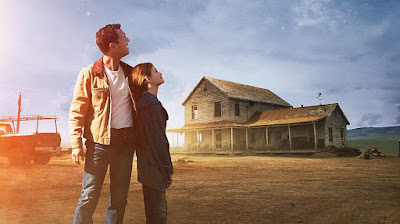Interstellar (2014)
Interstellar (2014)
Directed by Christopher Nolan;
Starring Matthew McConaughey, Anne Hathaway, Jessica Chastain
Rating: 10/10
Interstellar came at the end of 2014 to give us a Christmas
blockbuster worthy of leaving our warm hearths for. I saw it late after a
stretch abroad, but I’m glad I caught it on the big screen, even if it was the
‘Bijou’ screen of my local cinema. Some films excel at spectacle, and this
really deserved to be seen on the biggest, loudest screen possible, so count yourself
lucky if you managed it.
The film is a science fiction
epic, but it’s not an outlandish fantasy. Forget Avatar. Has anyone watched Avatar
recently? Interstellar feels grounded
in possibility with ideas full of personal conflict and universal philosophy.
The story begins some fifty odd years in the future on an Earth devastated by
crop blights. The world is becoming a barren dustbowl as humanity struggles to
feed itself.
Our hero is Cooper (Matthew
McConaughey) a widowed former pilot turned farmer who ekes out a living with
his father-in-law and two children Tom and Murphy. The film does well to
establish this world; a parent-teacher meeting where children are denied a
college application so they can become farmers and an early action sequence
where Cooper salvages a downed Indian drone for parts hint at the
environmental, technological and geopolitical situation of this future world.
The main narrative starts when
a mysterious signal leads the ever inquisitive Cooper to the remnant of NASA, helmed
by Cooper’s old professor Dr. Brand (frequent Nolan-collaborator Michael Caine)
who offers him the chance to join a secret mission to find a new homeworld for
humanity. A wormhole has been discovered near Saturn which leads to a system of
potentially habitable planets orbiting a supermassive black hole.
Here begins the struggle and
the decisions Cooper and his family must make. Should humanity continue to
fight the losing battle on Earth, or abandon it? Should a man leave his family
for the future of humanity, or live out what life he can with them, as best he
can on a dying world?
At the heart is Cooper’s
relationship with the daughter he leaves behind (Jessica Chastain) and her
struggle to forgive him as she grows up to become a scientist herself. The
relationship is paralleled with Brand’s daughter Amelia (Anne Hathaway) who
joins the mission to look for something else among the stars.
Christopher Nolan is a
twenty-first century auteur and his films are always ambitious, complex and
engaging. Even if that ambition is sometimes stretched, he never shrinks from a
bold idea. But it’s not just a philosophical narrative. While emotional through
and through, the film also explores its conflict through gripping action and
spectacular visuals, and its pioneering attitudes through the inclusion of
cutting edge scientific thought.
Okay, so you don’t have to
understand every part of the physics; some artistic licence has undoubtedly
been taken for the sake of story or spectacle, and there are ‘Star Trek’ times when characters with a
scientific background explain their complicated plans to each other with a
simple analogy (a technique immortalised by Fry in Futurama), but we’re here to watch a movie, not a lecture in
theoretical astrophysics.
The result is that the
characters not only explore foreboding new worlds of ice and oceans but deal
with the vaguely realistic implications of exploring wormholes and black holes,
such as time dilation and intense space-time-warping gravity. This is used to
great emotional effect; imagine communicating with your family at home when
hours of your time is years of theirs and your messages can ‘only’ travel at
the speed of light.
It’s enough that theoretical
physicist Kip Thorne was present as a consultant to know we’re in safe hands.
Thorne collaborated with Carl Sagan on the latter’s novel Contact, which became a film in 1997 and dealt with the
communication between a father and daughter across the void of space and also
happened to feature Matthew McConaughey in a supporting role.
Interstellar seems like a spiritual successor but stands on the
shoulders of another giant, that unforgettable epic journey to the edges of the
solar system and beyond: 2001: A Space
Odyssey (1968); although that film’s astronaut Dave had no family keeping
him on Earth. It’s worth mentioning here that the cubic robots that assist on
the mission are markedly less homicidal. The robots have been brilliantly
realised with inventive simplicity as real puppets played by actors and not CGI.
The effects as a whole are a
cinematic experience; the spaceship blasts through the void to ludicrous organ overlays
and emerges overlooking the black hole, a magnificently realised singularity of
ultimate light and darkness simulated using Thorne’s mathematics. Then a moment
of peace, all the more accentuated after the volume, allowing us to ponder the ‘gravity’
of the situation in more ways than one.
I read an article* explaining
that the pipe organ was for a long time the world’s most complex man-made
device, this scientific significance a possible reason behind its inclusion,
aside from the obvious spiritual associations. Organ pipes also have a visual
similarity to spaceship engines, reminding me of Boston Third Stage album cover where the band’s signature organ is presented
as just that.
My only word on the film’s ending
is that it comes very close to undercutting Cooper’s sacrifices by letting him
have his cake and eat it, but after the mind-bending finale, we’re on board
enough just to go along with the ride. So I’ll leave it there.
The word ‘stellar’ is
sometimes used to describe something of an extremely high standard, but it’s
hard to say now without sounding like you’re quoting Stanley Kowalski. I think
it’s time for a change, so this film gets full marks because it was Interstellar.



Comments
Post a Comment